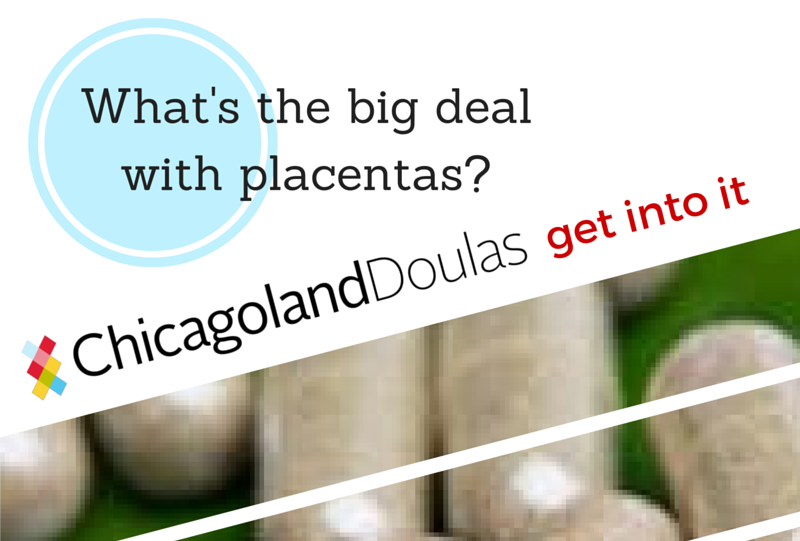A natural boost for energy, breast milk production, and healing
Thousands of mothers have their placenta encapsulated after giving birth. Consuming the placenta encourages re-balancing of hormones, stimulates milk production for breastfeeding, and assists in regulating moods in the first months after their baby is born.
We're sure you have many questions! Below is a list of frequent inquiries to help you make an informed decision about placenta encapsulation. All answers prepared by Chicagoland Doulas owner Anne Iverson!
FAQs about Placenta Encapsulation
Why should I encapsulate my placenta?
No human-made or organic supplement is on par with your placenta when it comes to helping your body transition after having a baby. When professionally encapsulated, your placenta is conveniently handy in the form of capsules (just like the herbal vitamins at the store), and it has a formula specifically beneficial to you. It is full of nutrients that can be absorbed gently during the first months of your postpartum period. Some of these nutrients are:
- Vitamin B6 – aids in making antibodies
- Vitamin E – for healing damaged cells
- Oxytocin hormone – essential for facilitating birth and breastfeeding
- Stem cells and growth factors
- Corticotrophin-releasing hormone (CRH) – responsible for decreasing stress levels
- Cytokines – fibroblasts that trigger cell metabolism, healing, and replacement of
- damaged cells and tissue
What kind of capsule do you use?
- We use capsules that are 100% vegan-certified, wheat and gluten-free, kosher, and halal. We also use gluten-free grain spirit to make tinctures.
How long do I take the capsules?
You can take the capsules as long as you feel you need them. Placing them in the refrigerator (or freezer for longer periods) will keep them fresh (and away from curious pets and children). Your specialist can also make a tincture for you that you can use for much longer than your capsules might last.
How long does encapsulation take?
- Encapsulation is a two-day process, and takes approximately 2 hours the first day and two hours the second day. The first day it is prepared and begins the process of dehydration. The second day it is placed into capsules and you and your postpartum placenta specialist will discuss consumption recommendations.
How many capsules should I expect from my placenta?
- Placentas come in all sizes, so the amount of capsules is different for every person. Your placenta will provide you with the amount your body needs. Typically the amount of capsules a placenta produces is about 100-250.
Is placenta encapsulation sanitary?
Yes. All supplies and surfaces are cleaned with an EPA-approved disinfectant and our specialist is specifically trained to work with blood-borne pathogens involved with placenta contact. We perform the entire process in your home, so that you may be sure that the process is safe, transparent, and free from outside contamination.
Does research show increased breast milk supply though placenta ingestions??
- Studies have shown from 1954 to the present that there are benefits to placenta consumption. They suggest that consuming your placenta can increase milk production, decrease stress levels, strengthen maternal bonding, and increase overall energy. The increasing popularity of encapsulation is expanding this field of research. Recent CDC recommendations and warnings have been based on a separate and very different process than what we use at Chicagoland Doulas, and we take special safety precautions that avoid those risks.
Will my hospital release my placenta when I am discharged?
- Each hospital policy is different, and in most cases there are some papers to fill out. Chicago hospitals are getting on board, and you should contact your birth place before your labor to make arrangements for release. It is a good idea to designate someone in your family (other than the birthing parent) to be in charge of transporting the placenta to your home. If the placenta is sent to the lab for study in the case of a birth complication, it will not be released.
How do I store my placenta after birth?
- Placentas are typically placed by hospital staff in a plastic bag inside a plastic container, and an additional plastic bag may be placed around the container itself. (If the placenta needs to leave the room at any point, make sure it is labeled well and that the staff knows not to add any chemicals to it and to refrigerate it). As soon as possible--absolutely within 3-4 hours-- put this container in a cooler with ice so that it can remain cool until you are able to refrigerate it at home (within 10 hours). Encapsulation should ideally occur within 1-3 days, but if that is not possible, place the placenta in the freezer. The placenta should not remain in the fridge for more than 3-4 days.
How long can my placenta stay frozen?
- Your placenta can stay frozen for up to a year and still have benefits for you. However, we believe encapsulating the placenta “sooner the better” aids in postpartum transition most effectively.
Have a question we didn't cover? Feel free to reach out personally via email or social media!
Instagram: @chicagolanddoulas | Facebook: Chicagoland Doulas | Pinterest: ChiDoulas
info@chidoulas.com | 712-540-5917




